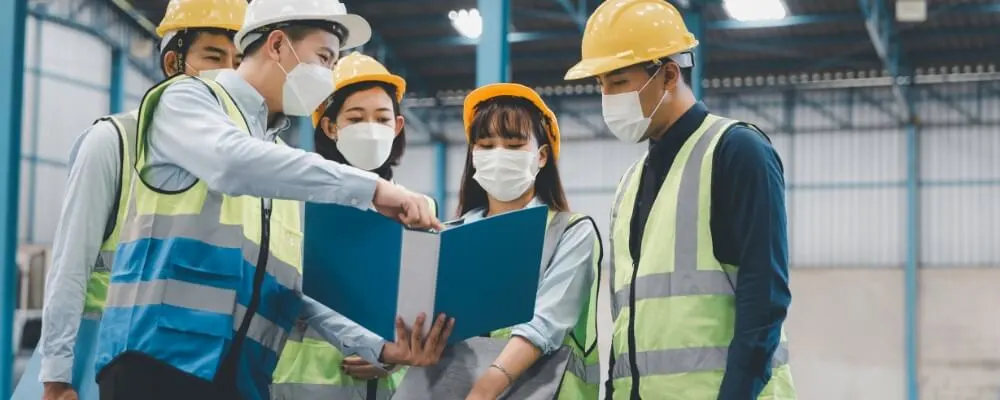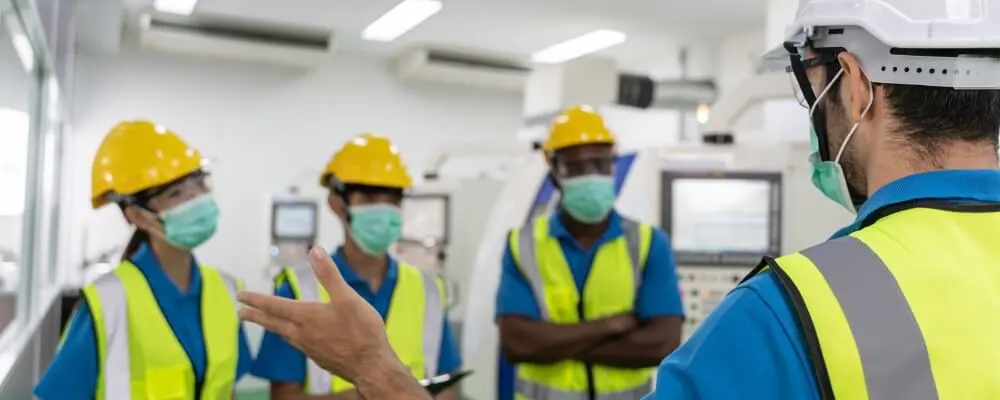Navigating the intricate web of workplace safety can often seem daunting. Yet, at the heart of the UK’s approach to ensuring the health and safety of its workforce lies the Health and Safety at Work Act (HSWA). This pivotal legislation has fundamentally transformed the landscape of occupational safety, setting the gold standard for other nations to emulate.
In this comprehensive guide, we’ll journey through the historical backdrop that underscored the need for the HSWA, delve deep into its key provisions, and shine a spotlight on the mechanisms that bring these regulations to life. We’ll also explore the specific safety regulations tailored for diverse sectors and, importantly, evaluate the tangible impact and myriad benefits of the HSWA.
Whether you’re an employer striving for excellence in workplace safety, an employee keen on understanding your rights, or someone curious about the evolution and intricacies of workplace safety in the UK, this blog promises insights and information to enlighten and empower you. Let’s embark on this exploration together.
Health and Safety at Work Act
In many jurisdictions, the Health and Safety at Work Act, or the HSWA or the HASAWA, governs occupational safety and health. Initially introduced in the United Kingdom in 1974, it laid the groundwork for ensuring employers provide all workers with a safe and healthy work environment. The Act outlines the duties and responsibilities of both employers and employees, promoting the welfare of individuals in the workplace.
Occupational health and safety are critical to fostering a positive work environment. Regulations under acts like the HSWA are vital as they help prevent accidents, injuries, and illnesses at work, thereby safeguarding the well-being of employees. Furthermore, by adhering to these rules, organizations can mitigate legal risks and potential financial losses associated with workplace accidents and diseases.
These protocols guide businesses in creating systematic approaches to manage safety and health, promoting a culture that values the welfare of its employees, which in turn can boost morale and enhance productivity. It embodies the ethos that the well-being of employees should be a paramount consideration in any workplace, paving the way for a safer, healthier, and more productive society.

Historical Context of Workplace Safety Regulations
Pre-HSWA Landscape
Before introducing the Health and Safety at Work Act, workplace safety regulations in many countries, including the UK, were fragmented and often inadequate. The Industrial Revolution in the 18th and 19th centuries saw a massive surge in factory-based production. With this rapid industrialization came a rise in workplace accidents, many severe, due to the nature of the machinery and processes in use. Workers, including children, often toiled in hazardous conditions with little to no safety measures in place.
Several individual Acts were passed during the 19th and early 20th centuries targeting specific industries and hazards. For instance, the Factories Act of 1833 aimed to improve conditions in factories, and the Mines Act of 1842 prohibited the employment of women and children underground in coal mines. However, these early regulations were often limited in scope, reactive, and lacked a cohesive, overarching strategy for workplace safety.
Trade unions and labor movements played a significant role in pushing for improved working conditions. Their persistent campaigning highlighted the need for broader, more comprehensive legislation. Yet, despite these efforts, by the mid-20th century, many industries still lacked sufficient regulations, and there were considerable inconsistencies in enforcing existing laws.
The Need for a Comprehensive Law
By the 1970s, it became evident that the piecemeal approach to occupational safety and health was ineffective. The existing laws were not keeping pace with technological advancements, machinery, and workplace practices. There was a clear and pressing need for a comprehensive law covering all industries and workers, ensuring consistent standards and practices.
The Health and Safety at Work Act was introduced to address this void. It aimed to consolidate and modernize the fragmented laws into one cohesive piece of legislation, setting clear standards and duties for employers and employees. The Act was intended to be more proactive, emphasizing the prevention of accidents and illnesses rather than just reacting to them.
Moreover, with the global economy becoming more interconnected, there was also an understanding that improved safety standards could enhance a country’s competitive position by reducing work-related illnesses and accidents, leading to decreased absenteeism and increased productivity.
The Health and Safety at Work Act was a much-needed reform from the lessons learned from centuries of industrial development. It symbolized a shift from isolated, reactive measures to a holistic, proactive approach, aiming to protect all workers irrespective of their job or industry.

Key Provisions of the Health and Safety at Work Act
The Health and Safety at Work Act, often abbreviated as HSWA or HASAWA, is a cornerstone of workplace safety regulations. It protects employees, employers, and the public from workplace risks and enhances individuals’ health and welfare. Here’s a deeper look into the Act’s key provisions:
Main Objectives of the Act
- Promotion of General Health and Safety: The primary goal is to ensure that workplaces are as safe and healthy as possible, reducing work-related injuries and illnesses.
- Comprehensive Coverage: The Act aims to provide comprehensive safety and health regulations across all industries, ensuring consistent standards.
- Duty of Care: Establishing a clear duty of care where employers and employees have defined responsibilities to ensure health and safety.
- Regulatory Framework: Setting a foundation for regulatory bodies, like the Health and Safety Executive (HSE) in the UK, to supervise, guide, and enforce the Act’s provisions.
Responsibilities Under the Act
Employers
- Provide Safe Work Environments: Employers must ensure that workplaces are free from health risks and have safety measures.
- Safe Use of Work Equipment: This includes providing, maintaining, and safely using work equipment and systems.
- Information and Training: Employers must provide necessary training, information, instruction, and supervision to ensure workers’ safety.
- Assessment and Control: Risk assessments should be routinely conducted, and measures should be established to mitigate these risks.
- Welfare Provisions: Employers should ensure the availability of essential amenities like clean water, sanitary conveniences, and adequate rest areas.
Employees
- Duty of Care: Employees must take care of their health and safety and others who might be affected by their actions or omissions.
- Compliance: Employees must comply with their employer’s safety instructions and procedures.
- Reporting: Employees are responsible for reporting any hazards or potential risks they identify.
Self-employed
- Health and Safety of Others: Self-employed individuals must ensure that their work activities do not endanger themselves or others.
- Compliance: Like employees, they must comply with the Act’s regulations relevant to their work.
Duty to Ensure the Health, Safety, and Welfare of All Employees
One of the most crucial aspects of the HSWA is the explicit duty placed on employers to guarantee all employees’ health, safety, and welfare. This duty encompasses several key areas:
- Safe Operations and Maintenance: Employers must ensure that the workplace, including access and exit points, is safe and poses no health risks. This also applies to the maintenance and operation of workplace equipment and systems.
- Adequate Training: Employees should be trained to handle equipment safely and recognize potential hazards.
- Ventilation, Temperature, and Lighting: The workplace should have adequate ventilation, reasonable temperatures, and suitable lighting for all tasks.
- Emergency Procedures: Clear procedures should be in place for emergencies, such as fire or equipment failure.
In essence, the Health and Safety at Work Act established a comprehensive framework that places a significant duty of care on employers while recognizing the role employees and the self-employed play in fostering a safe work environment. It underscores the belief that a healthy and safe workplace is a collective responsibility, requiring effort and vigilance from all parties involved.

Risk Assessment and Management
In the context of the Health and Safety at Work Act and similar regulations worldwide, risk assessment stands as a pivotal component in ensuring workplace safety. It is an organized process of identifying potential hazards, evaluating the associated risks, and determining suitable measures to eliminate or control them.
Requirement for Risk Assessments in Workplaces
The Health and Safety at Work Act, among other regulatory provisions, requires employers to carry out risk assessments to ensure the health and safety of their employees and any others that may be affected by their business operations. This proactive approach aims to identify potential hazards before they cause harm and put preventive and protective measures in place.
Conducting and Documenting Risk Assessments
- Identify the Hazards: This involves observing the workplace, reviewing accident and ill-health records, consulting with employees, and referencing relevant industry guidance to pinpoint potential hazards.
- Decide Who Might Be Harmed and How: For every hazard identified, employers must determine who might be at risk. This could include employees, contractors, visitors, or even the public.
- Evaluate the Risks and Decide on Precautions: For each hazard, the likelihood and severity of the risk should be evaluated. After understanding the risk, appropriate preventive and protective measures should be decided upon.
- Document the Findings: For businesses of a certain size or in specific industries, it’s mandatory to record the significant risk assessment findings. This documentation should include the hazards identified, how people might be harmed, and the measures to manage these risks.
- Review and Update: Risk assessments should not be a one-off activity. They need to be reviewed regularly and updated, especially if there are significant changes in the business operations or reasons to believe the original assessment is no longer valid.
Importance of Managing and Mitigating Workplace Risks
Prevention of Accidents and Illness: Proactive risk management ensures that potential hazards are identified and addressed before they can result in accidents or ill health.
- Legal Compliance: Risk assessments are not just best practices but often legal requirements. By conducting them, businesses ensure they comply with laws and can avoid potential legal penalties.
- Financial Savings: Accidents can be costly. They can result in medical expenses, compensation claims, repairs, and even downtime in operations. By mitigating risks, businesses can avoid these unforeseen costs.
- Boosting Employee Morale and Productivity: When employees know their employer takes their safety seriously, it can increase job satisfaction, reduce absenteeism, and enhance productivity.
- Reputation Management: A safe business is seen as a responsible business. It attracts better talent, wins customers’ trust, and even offers a competitive advantage in the market.
Risk assessments lie at the heart of an effective health and safety management system. They provide a structured way to identify potential threats, assess the magnitude of risks, and prioritize actions. Properly managing and mitigating workplace risks is a regulatory necessity and a sound business practice.

Who enforces Health and Safety Legislation?
Health and safety legislation enforcement varies depending on the country and specific jurisdiction. However, in the context of the Health and Safety at Work Act (HSWA) from the United Kingdom, the primary enforcement bodies are:
1. Health and Safety Executive (HSE)
This is the main regulatory body responsible for enforcing health and safety legislation in the UK. The HSE oversees most industries and sectors, providing guidance, conducting inspections, investigating breaches, and, where necessary, prosecuting offenders.
2. Local Authorities (LAs)
In some areas and sectors, particularly those covering the retail, leisure, and office sectors, Local Authorities are responsible for enforcing health and safety regulations. Their enforcement powers and duties are similar to the HSE’s but operate within their respective territorial jurisdictions.
3. Other specialized regulatory bodies
In certain industries, additional regulatory bodies may have a role in overseeing specific health and safety aspects. For example:
- The Office for Nuclear Regulation (ONR) is responsible for safety in the nuclear industry.
- The Civil Aviation Authority (CAA) oversees safety in the aviation sector.
- The Office of Rail and Road (ORR) enforces health and safety on railways.
These bodies have the authority to inspect workplaces, investigate complaints and incidents, and take enforcement action when necessary. This action can range from advising and issuing improvement or prohibition notices to prosecuting companies or individuals violating health and safety laws.
It’s important to note that while the UK’s enforcement structure is relatively centralized, with the HSE playing a pivotal role, health and safety legislation in other countries might involve a wider array of agencies and bodies, each with its specific oversight domain.

Employee Rights and Participation
Ensuring health and safety at work is not just employers’ duty; employees have rights and responsibilities. These rights are paramount as they empower workers to contribute to their safety and the safety of their colleagues, fostering a proactive safety culture.
Employees’ Rights to a Safe Working Environment
- Right to Information: Employees have the right to be informed about the hazards in their workplace, precautions to take, and the protocols in place for their safety.
- Right to Training: Workers should be trained on safe work practices, and this training should be refreshed periodically, especially when new equipment, substances, or procedures are introduced.
- Right to Protective Equipment: If specific risks cannot be eliminated, employees have the right to personal protective equipment without any cost.
- Right to Refuse Unsafe Work: If an employee genuinely believes that a particular work task poses an imminent risk to their health or safety, they have the right to refuse it, though this is subject to various factors and jurisdictional regulations.
- Right to Confidentiality: Employees should be able to report hazards or incidents without fear of retaliation, and their confidentiality should be maintained where requested.
Mechanisms for Employees to Report Safety Concerns
- Direct Reporting to Supervisors: Employees should be encouraged to report concerns directly to their immediate supervisor or manager.
- Safety Reporting Systems: Some organizations have formalized reporting systems, such as online platforms or physical suggestion boxes, where employees can lodge concerns.
- Whistleblower Protections: In some jurisdictions, whistleblower laws protect employees who report safety violations, ensuring they don’t face retaliation from employers.
- External Reporting: If internal reporting doesn’t lead to action, employees might have the option to report to external bodies like the Health and Safety Executive (HSE) or local authorities. However, this is often seen as a last resort.
Role of Safety Representatives and Safety Committees
Safety Representatives
- Appointed by recognized trade unions, safety representatives play a critical role in amplifying the voice of employees.
- They inspect workplace conditions, represent employees in consultations with employers, and investigate potential hazards or incidents.
- They act as a bridge between the general workforce and management, ensuring that safety concerns from the former are adequately conveyed and addressed by the latter.
Safety Committees
- These are formal groups consisting of representatives from both management and employees. Their main objective is to foster cooperation and collaboration in developing and maintaining safety standards.
- The committee meets regularly to discuss safety performance, review incidents, suggest improvements, and oversee the implementation of safety protocols.
- They play a role in reviewing risk assessments, devising safety campaigns, and enhancing the organization’s overall safety culture.
In essence, while employers are primarily responsible for ensuring a safe working environment, employees have a critical role to play. Their rights, the mechanisms in place for them to voice concerns, and the role of safety representatives and committees all work synergistically to create a holistic safety environment. This collaborative approach is crucial because a safe workplace is best achieved when everyone—regardless of rank or role—is actively engaged and committed to the cause.

Enforcement and Penalties
The Health and Safety Executive (HSE) is the primary regulatory body responsible for ensuring that employers in the UK adhere to the requirements set out in the Health and Safety at Work Act (HSWA). Their enforcement powers are broad and vary depending on the severity of the breach and potential harm caused.
How HSE Enforces the Act
Inspections
HSE inspectors can visit workplaces without prior notice to check for health and safety laws compliance. They assess the workplace conditions, practices, and adherence to safety protocols.
Investigations
In the event of a reported incident, accident, or dangerous occurrence, the HSE can launch an investigation to determine the cause and if there were any breaches in health and safety law.
Notices
- Improvement Notices: These are issued when an employer violates health and safety regulations, but the breach isn’t severe enough to warrant immediate action. The employer is given a specific period to rectify the issue.
- Prohibition Notices: If an inspector believes an activity poses a serious risk, they can issue a notice immediately, stopping it until the hazard is addressed.
Prosecutions
In serious violations, the HSE can prosecute the company or individual responsible. This can lead to court trials and, if found guilty, significant penalties.
Penalties for Non-compliance
- Fines: Companies can be fined heavily for breaching health and safety laws. The amount varies based on the severity of the breach, potential or actual harm caused, and the company’s turnover.
- Imprisonment: In extreme cases, particularly where there’s evidence of gross negligence or repeated violations, individuals (such as directors or managers) can face imprisonment.
- Reputational Damage: Besides formal penalties, companies that breach health and safety regulations can suffer severe reputational damage, which might impact their business operations and stakeholder trust.
Notable Cases
- Grenfell Tower Fire (2017): Though this tragedy had multiple facets, issues related to health and safety were at its core. The fire led to 72 deaths, and investigations highlighted various safety failings. This case is a grim reminder of the consequences of neglecting health and safety regulations.
- Alton Towers ‘Smiler Rollercoaster Accident (2015): A collision on the Smiler rollercoaster resulted in multiple serious injuries. Investigations found that the theme park’s operator, Merlin Attractions, had breached health and safety laws. The company was fined £5 million.
- Bosley Mill Explosion (2015): An explosion at a wood treatment works in Cheshire killed four people. The subsequent investigation unveiled a series of safety breaches, leading to the prosecution of multiple individuals and the company itself.
Each of these cases underscores the critical importance of adhering to health and safety regulations and the potentially devastating consequences of failing to do so. The HSE’s enforcement powers and the legal penalties for non-compliance ensure that all workplaces prioritize the safety and well-being of their employees and the public.

Sector-Specific Regulations
The Health and Safety at Work Act (HSWA) is a foundational legislation that sets out the general principles for health and safety in workplaces across the UK. However, given the vast differences in risks and practices between sectors, a one-size-fits-all approach isn’t practical. As such, various sector-specific regulations and guidelines have been developed to tailor health and safety practices to the unique demands of each industry.
Different Industry Applications of the HSWA
Construction
- Construction (Design and Management) Regulations (CDM): These regulations focus on health, safety, and welfare when undertaking construction projects. The CDM mandates roles like the Principal Designer and Principal Contractor to ensure safety from project design to completion.
Chemicals & Hazardous Substances
- Control of Substances Hazardous to Health (COSHH): This regulation mandates employers to control substances that can harm workers’ health. It requires risk assessments, control measures, and training related to hazardous substances.
- Chemical (Hazard Information and Packaging for Supply) Regulations (CHIP): Before being replaced by the CLP Regulation, CHIP ensured chemicals were clearly labeled and provided information about their hazards.
Agriculture
- The Use of Equipment at Work Regulations pertains to the machinery commonly used in agriculture, emphasizing proper maintenance and operation to ensure worker safety.
- The Welfare of Farmed Animals Regulations: While this is more about animal welfare, there’s an overlap with worker safety, especially concerning the transmission of diseases.
Gas, Oil, and Mining
- The Offshore Installations (Offshore Safety Directive) (Safety Case etc.) Regulations: This focuses on health and safety for offshore oil and gas operations.
- The Mines Regulations aim to manage and control risks from underground mining operations.
Healthcare
- The Management of Health and Safety at Work Regulations: While applicable to all sectors in healthcare, this emphasizes risk assessments related to patient handling and transportation, exposure to diseases, and the use of medical equipment.
Transport
- Railways and Other Guided Transport Systems (Safety) Regulations: This focuses on the safety of railways, tramways, and other guided transport systems.
- Merchant Shipping and Fishing Vessels (Health and Safety at Work) Regulations: This pertains to the safety of workers on ships and fishing vessels.
Office Environments
- The Display Screen Equipment Regulations: This addresses potential health issues from using display screens, emphasizing proper ergonomics, regular breaks, and eye tests.
- The Workplace (Health, Safety, and Welfare) Regulations: While applicable to many sectors, in office settings, it covers aspects like ventilation, temperature, lighting, and cleanliness.
Nuclear
- The Nuclear Installations Act governs the safety of nuclear sites, including the handling and disposal of radioactive substances.
These sector-specific regulations operate in tandem with the general duties laid out in the HSWA. They clarify the practices businesses in these sectors must adopt to uphold health and safety standards. While the HSWA provides a broad framework, these detailed regulations ensure that each industry’s unique challenges and risks are appropriately addressed.

Impact and Benefits Of the Health and Safety at Work Act (HSWA)
The Health and Safety at Work Act (HSWA) has had a transformative effect on the safety culture within the UK. Since its inception, the Act has significantly reduced workplace accidents, injuries, and fatalities.
Statistics and Case Studies
- Trends in Workplace Fatalities: Before the Act’s introduction in 1974, the number of workplace fatalities in the UK was alarmingly high. For example, in 1974, there were approximately 651 recorded fatal injuries to employees. Fast forward to the 2010s and early 2020s, and the annual number of fatal injuries dropped below 150. This represents a decline of over 75%.
- Non-fatal Injuries: The impact on non-fatal injuries is also noteworthy. In the mid-1980s, over 300,000 reported non-fatal injuries in workplaces each year. By the early 2020s, this number had been reduced to below 70,000, representing a more than 75% decrease.
- Case Study – The Construction Industry: Historically, construction has been one of the riskiest industries in the UK. Introducing sector-specific regulations like the Construction (Design and Management) Regulations under the HSWA umbrella led to more robust safety measures. As a result, from the late 1980s to the early 2020s, the fatal injury rate in the construction sector decreased by approximately 80%.
- Case Study – The Agricultural Sector: Similarly, the agricultural sector, which remains one of the UK’s most hazardous sectors, saw improvements in safety measures. The application of HSWA and the related sector-specific guidelines significantly dropped fatal and non-fatal injuries over the years.
Impact on Workplace Safety
- Enhanced Safety Culture: The Act has been pivotal in shifting workplace cultures, making safety a primary concern. It instilled a sense of shared responsibility, where both employers and employees work collaboratively to ensure a safe environment.
- Better Reporting Mechanisms: With the introduction of the Act, there was a greater emphasis on reporting accidents and near-misses. This fostered an environment where issues could be addressed proactively, preventing potential accidents.
- Employee Training: One of the tangible benefits of the Act was the increase in employee training. Workers became better informed about potential risks and how to handle them, reducing accident rates.
- Introduction of Safety Equipment: The Act played a role in emphasizing the importance of Personal Protective Equipment (PPE). Industries like construction, manufacturing, and chemicals witnessed a significant uptick in the use of PPE, directly contributing to reduced injury rates.
- Regular Safety Audits and Inspections: With HSE’s active role in enforcing the Act, workplaces became more diligent in conducting safety audits and inspections, ensuring compliance with regulations, and identifying potential hazards.
The Health and Safety at Work Act has been a cornerstone of the UK’s workplace safety approach. Its impact, as evidenced by the reduction in accidents and the general improvement in workplace safety cultures, has been profound. Not only did it pave the way for a safer working environment, but it also fostered a mindset where safety became a shared responsibility, ensuring that workplaces prioritize the well-being of their employees.
Conclusion
The journey of workplace safety in the UK, anchored by the Health and Safety at Work Act (HSWA), is a testament to the nation’s commitment to safeguarding its workforce. As we’ve traversed through the annals of its history, the meticulous structures in place, and its profound impact, one thing becomes abundantly clear: safety is not just a legal obligation but a moral imperative. The HSWA not only stands as a beacon of regulatory foresight but also symbolizes the collaborative effort between employers, employees, and regulators in achieving a shared goal of a safer, healthier work environment.
This holistic approach to health and safety showcases the transformative power of collective responsibility. While regulations set the framework, every stakeholder’s shared commitment brings about meaningful change. As we move forward in an ever-evolving work landscape, with new challenges and risks on the horizon, the foundational principles of the HSWA serve as a compass, guiding us toward a future where every individual can work with dignity, assurance, and security. Workplace safety is ongoing, but with the HSWA as our guide, the path ahead looks promising and secure.

